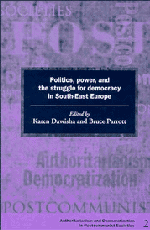Book contents
- Frontmatter
- Contents
- List of tables
- List of figures
- List of contributors
- Preface
- 1 Perspectives on postcommunist democratization
- 2 Democratization and political participation: research concepts and methodologies
- The former Yugoslavia
- 3 Embattled democracy: postcommunist Croatia in transition
- 4 Bosnia Herzegovina: a case of failed democratization
- 5 A failed transition: the case of Serbia
- 6 Democratization in Slovenia – the second stage
- 7 The Republic of Macedonia: finding its way
- Albania, Bulgaria, and Romania
- Appendix
- Index
6 - Democratization in Slovenia – the second stage
Published online by Cambridge University Press: 01 June 2011
- Frontmatter
- Contents
- List of tables
- List of figures
- List of contributors
- Preface
- 1 Perspectives on postcommunist democratization
- 2 Democratization and political participation: research concepts and methodologies
- The former Yugoslavia
- 3 Embattled democracy: postcommunist Croatia in transition
- 4 Bosnia Herzegovina: a case of failed democratization
- 5 A failed transition: the case of Serbia
- 6 Democratization in Slovenia – the second stage
- 7 The Republic of Macedonia: finding its way
- Albania, Bulgaria, and Romania
- Appendix
- Index
Summary
The question of democracy is not so simple a matter as some writers suppose. Not only are there rival traditions of democracy, but even among those subscribing to the classical liberal tradition, there are differences between those advocating a maximal definition of democracy (and thereby imposing higher standards on the system) and those urging acceptance of a minimal definition (with the consequent lower standards thereby entailed).
Nor do controversies end there. Should a political party be understood, in the first place, as an electoral organization that seeks to obtain sinecures for its members, or should the emphasis be shifted to the programmatic aspirations that unite the members in common action in the first place? Even equality may be thought to be a murky concept (though not by this author). After all, some say, if a constitution proclaims the equality of women, then should not women be satisfied that this, in and of itself, constitutes the full measure of equality? Others dispute the position implied in this rhetorical question, and urge that there is a distinction between formal equality and real equality.
In the ensuing chapter, I shall be concerned with the subject of democratization in Slovenia, and, in the course of examining the Slovenian case, shall endeavor to shed some light on the nature of democracy itself.
The legacy of the past
As is self-evident, the transition in Eastern Europe associated with the years 1989–90 was, among other things, a self-conscious attempt to escape the past.
- Type
- Chapter
- Information
- Publisher: Cambridge University PressPrint publication year: 1997
- 5
- Cited by



